四级专项训练fast reading解题技巧
- 格式:doc
- 大小:27.00 KB
- 文档页数:2
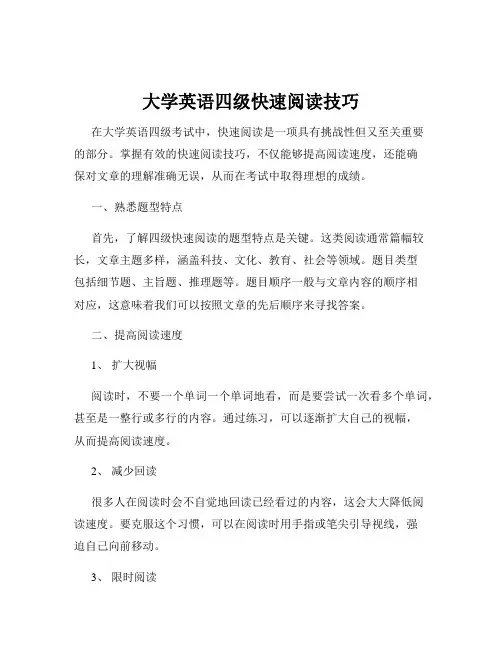
大学英语四级快速阅读技巧在大学英语四级考试中,快速阅读是一项具有挑战性但又至关重要的部分。
掌握有效的快速阅读技巧,不仅能够提高阅读速度,还能确保对文章的理解准确无误,从而在考试中取得理想的成绩。
一、熟悉题型特点首先,了解四级快速阅读的题型特点是关键。
这类阅读通常篇幅较长,文章主题多样,涵盖科技、文化、教育、社会等领域。
题目类型包括细节题、主旨题、推理题等。
题目顺序一般与文章内容的顺序相对应,这意味着我们可以按照文章的先后顺序来寻找答案。
二、提高阅读速度1、扩大视幅阅读时,不要一个单词一个单词地看,而是要尝试一次看多个单词,甚至是一整行或多行的内容。
通过练习,可以逐渐扩大自己的视幅,从而提高阅读速度。
2、减少回读很多人在阅读时会不自觉地回读已经看过的内容,这会大大降低阅读速度。
要克服这个习惯,可以在阅读时用手指或笔尖引导视线,强迫自己向前移动。
3、限时阅读平时练习时,给自己设定时间限制,逐渐缩短完成一篇阅读所需的时间。
这样可以增强阅读的紧迫感,提高阅读效率。
三、掌握阅读方法1、略读(Skimming)快速浏览文章的标题、副标题、开头和结尾段落,以及每段的首句和尾句,了解文章的大致内容和结构。
重点关注文章的主题、作者的观点和主要论点。
2、扫读(Scanning)根据题目中的关键词,迅速在文章中寻找相关的信息。
例如,人名、地名、数字、日期等都是比较容易定位的关键词。
找到关键词所在的段落或句子,仔细阅读,获取答案。
四、学会猜测词义在阅读过程中,难免会遇到生词。
这时候,不要立即停下来查字典,可以通过上下文的线索来猜测词义。
比如,根据生词前后的单词、句子,或者根据逻辑关系来推断生词的大致意思。
如果生词不影响对文章的理解,可以直接忽略。
五、注重逻辑关系文章中的逻辑关系对于理解和答题非常重要。
常见的逻辑关系有因果关系、转折关系、并列关系等。
例如,“because”“so”表示因果关系;“but”“however”表示转折关系;“and”“also”表示并列关系。
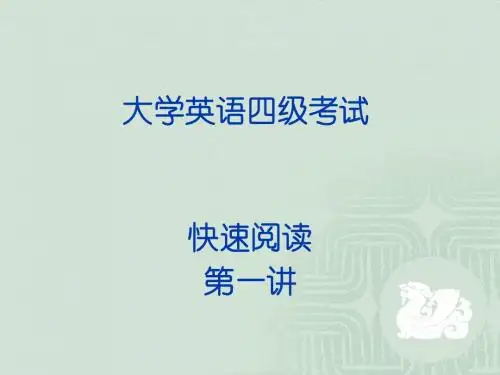
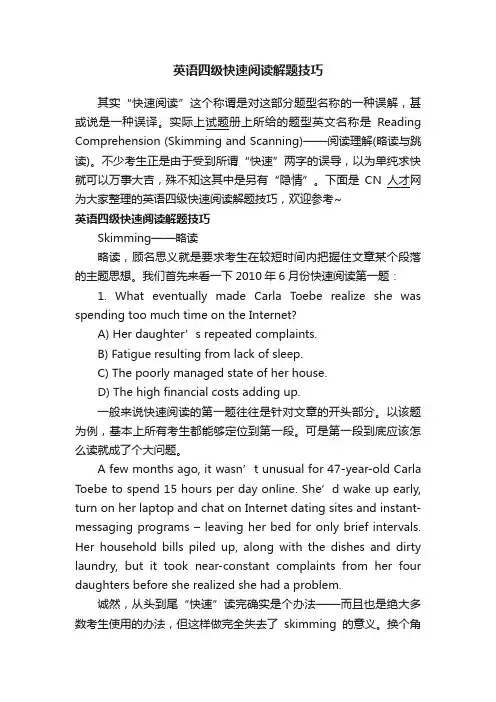
英语四级快速阅读解题技巧其实“快速阅读”这个称谓是对这部分题型名称的一种误解,甚或说是一种误译。
实际上试题册上所给的题型英文名称是Reading Comprehension (Skimming and Scanning)——阅读理解(略读与跳读)。
不少考生正是由于受到所谓“快速”两字的误导,以为单纯求快就可以万事大吉,殊不知这其中是另有“隐情”。
下面是CN人才网为大家整理的英语四级快速阅读解题技巧,欢迎参考~英语四级快速阅读解题技巧Skimming——略读略读,顾名思义就是要求考生在较短时间内把握住文章某个段落的主题思想。
我们首先来看一下2010年6月份快速阅读第一题:1. What eventually made Carla Toebe realize she was spending too much time on the Internet?A) Her daughter’s repeated complaints.B) Fatigue resulting from lack of sleep.C) The poorly managed state of her house.D) The high financial costs adding up.一般来说快速阅读的第一题往往是针对文章的开头部分。
以该题为例,基本上所有考生都能够定位到第一段。
可是第一段到底应该怎么读就成了个大问题。
A few months ago, it wasn’t unusual for 47-year-old Carla Toebe to spend 15 hou rs per day online. She’d wake up early, turn on her laptop and chat on Internet dating sites and instant-messaging programs – leaving her bed for only brief intervals. Her household bills piled up, along with the dishes and dirty laundry, but it took near-constant complaints from her four daughters before she realized she had a problem.诚然,从头到尾“快速”读完确实是个办法——而且也是绝大多数考生使用的办法,但这样做完全失去了skimming的意义。
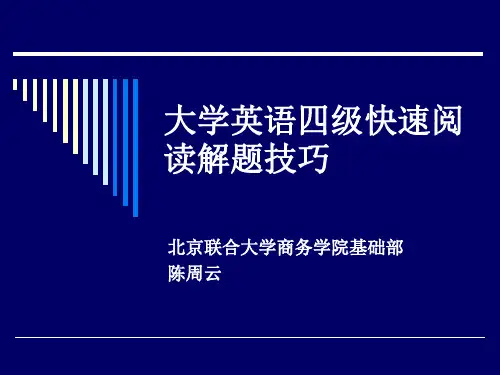
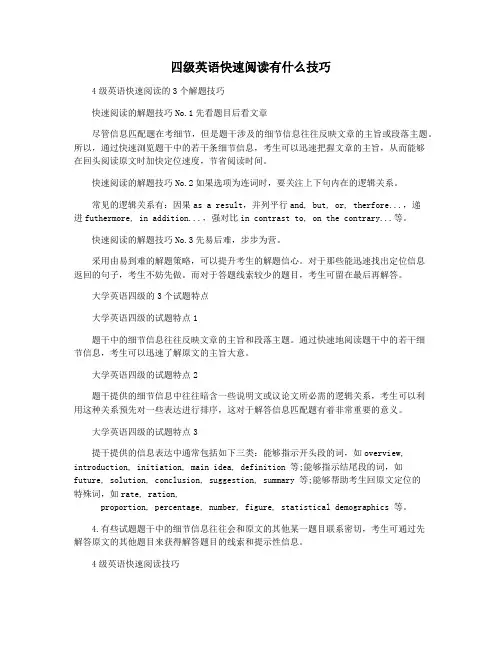
四级英语快速阅读有什么技巧4级英语快速阅读的3个解题技巧快速阅读的解题技巧No.1先看题目后看文章尽管信息匹配题在考细节,但是题干涉及的细节信息往往反映文章的主旨或段落主题。
所以,通过快速浏览题干中的若干条细节信息,考生可以迅速把握文章的主旨,从而能够在回头阅读原文时加快定位速度,节省阅读时间。
快速阅读的解题技巧No.2如果选项为连词时,要关注上下句内在的逻辑关系。
常见的逻辑关系有:因果as a result,并列平行and, but, or, therfore...,递进futhermore, in addition...,强对比in contrast to, on the contrary...等。
快速阅读的解题技巧No.3先易后难,步步为营。
采用由易到难的解题策略,可以提升考生的解题信心。
对于那些能迅速找出定位信息返回的句子,考生不妨先做。
而对于答题线索较少的题目,考生可留在最后再解答。
大学英语四级的3个试题特点大学英语四级的试题特点1题干中的细节信息往往反映文章的主旨和段落主题。
通过快速地阅读题干中的若干细节信息,考生可以迅速了解原文的主旨大意。
大学英语四级的试题特点2题干提供的细节信息中往往暗含一些说明文或议论文所必需的逻辑关系,考生可以利用这种关系预先对一些表达进行排序,这对于解答信息匹配题有着非常重要的意义。
大学英语四级的试题特点3提干提供的信息表达中通常包括如下三类:能够指示开头段的词,如overview, introduction, initiation, main idea, definition 等;能够指示结尾段的词,如future, solution, conclusion, suggestion, summary 等;能够帮助考生回原文定位的特殊词,如rate, ration,proportion, percentage, number, figure, statistical demographics 等。
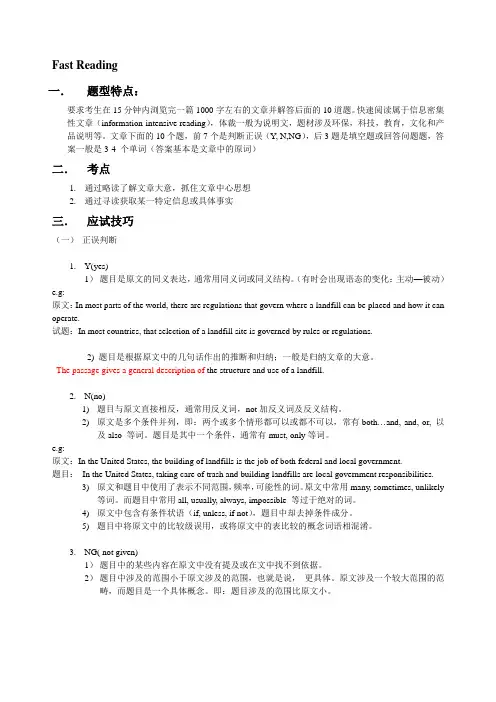
Fast Reading一.题型特点:要求考生在15分钟内浏览完一篇1000字左右的文章并解答后面的10道题。
快速阅读属于信息密集性文章(information-intensive reading),体裁一般为说明文,题材涉及环保,科技,教育,文化和产品说明等。
文章下面的10个题,前7个是判断正误(Y, N,NG),后3题是填空题或回答问题题,答案一般是3-4 个单词(答案基本是文章中的原词)二.考点1.通过略读了解文章大意,抓住文章中心思想2.通过寻读获取某一特定信息或具体事实三.应试技巧(一)正误判断1.Y(yes)1)题目是原文的同义表达,通常用同义词或同义结构。
(有时会出现语态的变化:主动—被动)e.g:原文:In most parts of the world, there are regulations that govern where a landfill can be placed and how it can operate.试题:In most countries, that selection of a landfill site is governed by rules or regulations.2) 题目是根据原文中的几句话作出的推断和归纳;一般是归纳文章的大意。
The passage gives a general description of the structure and use of a landfill.2.N(no)1)题目与原文直接相反,通常用反义词,not加反义词及反义结构。
2)原文是多个条件并列,即:两个或多个情形都可以或都不可以,常有both…and, and, or, 以及also 等词。
题目是其中一个条件,通常有must, only等词。
e.g:原文:In the United States, the building of landfills is the job of both federal and local government.题目:In the United States, taking care of trash and building landfills are local government responsibilities.3)原文和题目中使用了表示不同范围,频率,可能性的词。
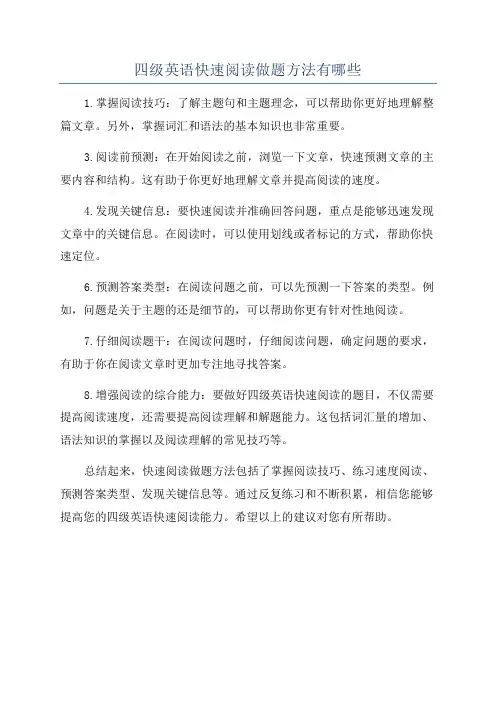
四级英语快速阅读做题方法有哪些
1.掌握阅读技巧:了解主题句和主题理念,可以帮助你更好地理解整篇文章。
另外,掌握词汇和语法的基本知识也非常重要。
3.阅读前预测:在开始阅读之前,浏览一下文章,快速预测文章的主要内容和结构。
这有助于你更好地理解文章并提高阅读的速度。
4.发现关键信息:要快速阅读并准确回答问题,重点是能够迅速发现文章中的关键信息。
在阅读时,可以使用划线或者标记的方式,帮助你快速定位。
6.预测答案类型:在阅读问题之前,可以先预测一下答案的类型。
例如,问题是关于主题的还是细节的,可以帮助你更有针对性地阅读。
7.仔细阅读题干:在阅读问题时,仔细阅读问题,确定问题的要求,有助于你在阅读文章时更加专注地寻找答案。
8.增强阅读的综合能力:要做好四级英语快速阅读的题目,不仅需要提高阅读速度,还需要提高阅读理解和解题能力。
这包括词汇量的增加、语法知识的掌握以及阅读理解的常见技巧等。
总结起来,快速阅读做题方法包括了掌握阅读技巧、练习速度阅读、预测答案类型、发现关键信息等。
通过反复练习和不断积累,相信您能够提高您的四级英语快速阅读能力。
希望以上的建议对您有所帮助。
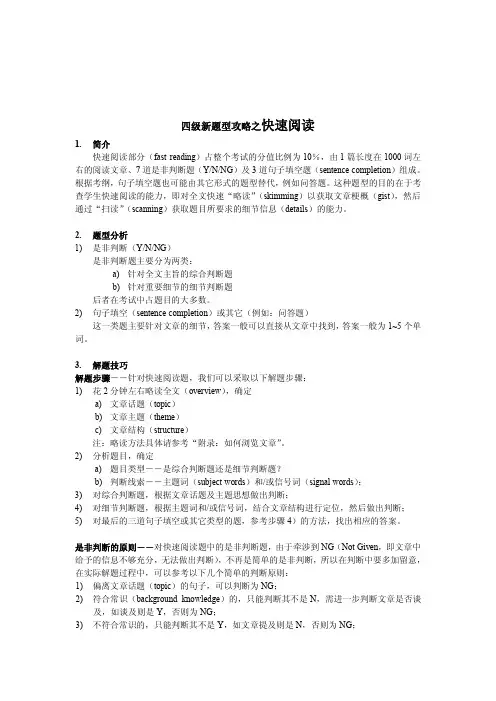
四级新题型攻略之快速阅读1.简介快速阅读部分(fast reading)占整个考试的分值比例为 10%,由1 篇长度在 1000词左右的阅读文章、7 道是非判断题(Y/N/NG)及3 道句子填空题(sentence completion)组成。
根据考纲,句子填空题也可能由其它形式的题型替代,例如问答题。
这种题型的目的在于考 查学生快速阅读的能力,即对全文快速“略读”(skimming)以获取文章梗概(gist),然后(scanning)获取题目所要求的细节信息(details)的能力。
通过“扫读”2.题型分析1)是非判断(Y/N/NG)是非判断题主要分为两类:a)针对全文主旨的综合判断题b)针对重要细节的细节判断题后者在考试中占题目的大多数。
2)句子填空(sentence completion)或其它(例如:问答题)这一类题主要针对文章的细节, 答案一般可以直接从文章中找到, 答案一般为 1~5 个单词。
3.解题技巧解题步骤――针对快速阅读题,我们可以采取以下解题步骤:1)花 2 分钟左右略读全文(overview),确定a)文章话题(topic)b)文章主题(theme)c)文章结构(structure)。
注:略读方法具体请参考“附录:如何浏览文章”2)分析题目,确定a)题目类型――是综合判断题还是细节判断题?b)判断线索――主题词(subject words)和/或信号词(signal words);3)对综合判断题,根据文章话题及主题思想做出判断;4)对细节判断题,根据主题词和/或信号词,结合文章结构进行定位,然后做出判断;5)对最后的三道句子填空或其它类型的题,参考步骤 4)的方法,找出相应的答案。
是非判断的原则――对快速阅读题中的是非判断题,由于牵涉到NG(Not Given,即文章中给予的信息不够充分,无法做出判断),不再是简单的是非判断,所以在判断中要多加留意, 在实际解题过程中,可以参考以下几个简单的判断原则:1)偏离文章话题(topic)的句子,可以判断为 NG;2)符合常识(background knowledge)的,只能判断其不是 N,需进一步判断文章是否谈及,如谈及则是 Y,否则为NG;3)不符合常识的,只能判断其不是 Y,如文章提及则是N,否则为 NG;4)与文章主题(theme)相符的,一定是 Y,反之一定是 N,不可能是 NG;5)进行事实判断时,需注意包含、交集、非交集的关系;6)注意转折关系,如果出现 A.... But/However B is C 的句型,则基本可以判断 A is not C,可据此进行判断。
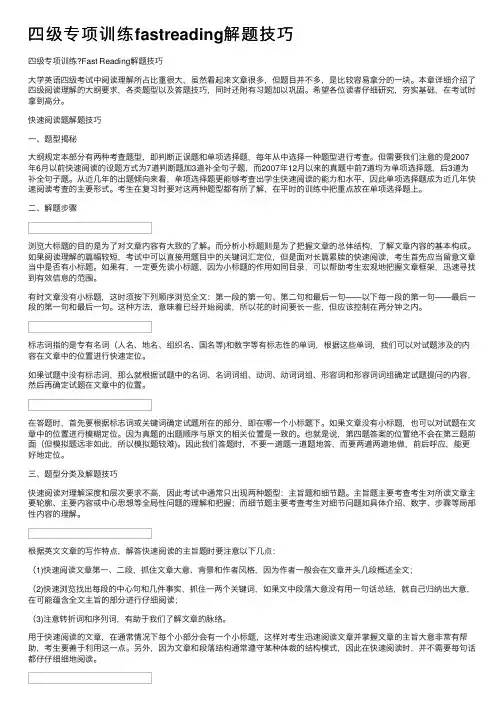
四级专项训练fastreading解题技巧四级专项训练?Fast Reading解题技巧⼤学英语四级考试中阅读理解所占⽐重很⼤,虽然看起来⽂章很多,但题⽬并不多,是⽐较容易拿分的⼀块。
本章详细介绍了四级阅读理解的⼤纲要求,各类题型以及答题技巧,同时还附有习题加以巩固。
希望各位读者仔细研究,夯实基础,在考试时拿到⾼分。
快速阅读题解题技巧⼀、题型揭秘⼤纲规定本部分有两种考查题型,即判断正误题和单项选择题,每年从中选择⼀种题型进⾏考查。
但需要我们注意的是2007年6⽉以前快速阅读的设题⽅式为7道判断题加3道补全句⼦题,⽽2007年12⽉以来的真题中前7道均为单项选择题,后3道为补全句⼦题。
从近⼏年的出题倾向来看,单项选择题更能够考查出学⽣快速阅读的能⼒和⽔平,因此单项选择题成为近⼏年快速阅读考查的主要形式。
考⽣在复习时要对这两种题型都有所了解,在平时的训练中把重点放在单项选择题上。
⼆、解题步骤浏览⼤标题的⽬的是为了对⽂章内容有⼤致的了解。
⽽分析⼩标题则是为了把握⽂章的总体结构,了解⽂章内容的基本构成。
如果阅读理解的篇幅较短,考试中可以直接⽤题⽬中的关键词汇定位,但是⾯对长篇累牍的快速阅读,考⽣⾸先应当留意⽂章当中是否有⼩标题。
如果有,⼀定要先读⼩标题,因为⼩标题的作⽤如同⽬录,可以帮助考⽣宏观地把握⽂章框架,迅速寻找到有效信息的范围。
有时⽂章没有⼩标题,这时须按下列顺序浏览全⽂:第⼀段的第⼀句、第⼆句和最后⼀句——以下每⼀段的第⼀句——最后⼀段的第⼀句和最后⼀句。
这种⽅法,意味着已经开始阅读,所以花的时间要长⼀些,但应该控制在两分钟之内。
标志词指的是专有名词(⼈名、地名、组织名、国名等)和数字等有标志性的单词,根据这些单词,我们可以对试题涉及的内容在⽂章中的位置进⾏快速定位。
如果试题中没有标志词,那么就根据试题中的名词、名词词组、动词、动词词组、形容词和形容词词组确定试题提问的内容,然后再确定试题在⽂章中的位置。
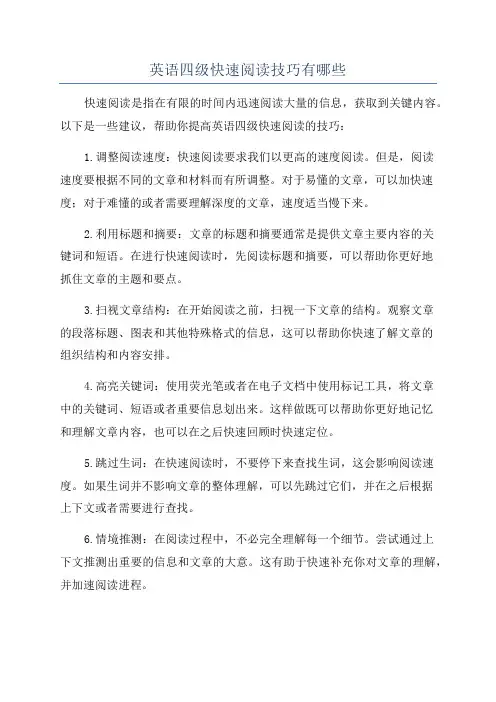
英语四级快速阅读技巧有哪些快速阅读是指在有限的时间内迅速阅读大量的信息,获取到关键内容。
以下是一些建议,帮助你提高英语四级快速阅读的技巧:1.调整阅读速度:快速阅读要求我们以更高的速度阅读。
但是,阅读速度要根据不同的文章和材料而有所调整。
对于易懂的文章,可以加快速度;对于难懂的或者需要理解深度的文章,速度适当慢下来。
2.利用标题和摘要:文章的标题和摘要通常是提供文章主要内容的关键词和短语。
在进行快速阅读时,先阅读标题和摘要,可以帮助你更好地抓住文章的主题和要点。
3.扫视文章结构:在开始阅读之前,扫视一下文章的结构。
观察文章的段落标题、图表和其他特殊格式的信息,这可以帮助你快速了解文章的组织结构和内容安排。
4.高亮关键词:使用荧光笔或者在电子文档中使用标记工具,将文章中的关键词、短语或者重要信息划出来。
这样做既可以帮助你更好地记忆和理解文章内容,也可以在之后快速回顾时快速定位。
5.跳过生词:在快速阅读时,不要停下来查找生词,这会影响阅读速度。
如果生词并不影响文章的整体理解,可以先跳过它们,并在之后根据上下文或者需要进行查找。
6.情境推测:在阅读过程中,不必完全理解每一个细节。
尝试通过上下文推测出重要的信息和文章的大意。
这有助于快速补充你对文章的理解,并加速阅读进程。
7.练习阅读更多的英语材料:快速阅读是一项需要长期练习的技巧。
通过多读英语材料,如新闻、文章、小说等,可以提高阅读速度和理解能力。
8.制定阅读计划:在备考四级时,制定一个合理的阅读计划是必要的。
设置每天或每周的阅读目标,按时完成。
这样可以在短时间内增加阅读量,并锻炼自己的快速阅读能力。
9.运用阅读技巧和策略:学习并灵活运用一些阅读技巧和策略,如略读、预测、推理等,帮助你更有效地获取文章的关键信息。
可以通过阅读相关阅读技巧书籍或者参加相关的培训课程来提高技巧和策略。
10.保持专注和投入:快速阅读需要集中注意力和投入精力,因此保持专注和集中阅读是非常重要的。
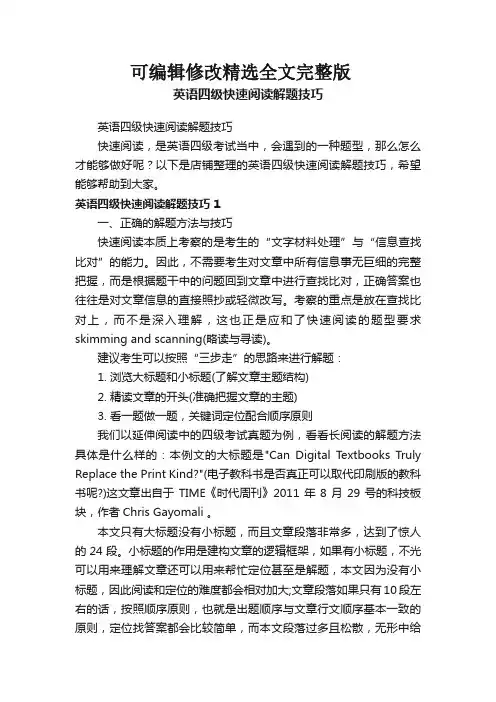
可编辑修改精选全文完整版英语四级快速阅读解题技巧英语四级快速阅读解题技巧快速阅读,是英语四级考试当中,会遇到的一种题型,那么怎么才能够做好呢?以下是店铺整理的英语四级快速阅读解题技巧,希望能够帮助到大家。
英语四级快速阅读解题技巧 1一、正确的解题方法与技巧快速阅读本质上考察的是考生的“文字材料处理”与“信息查找比对”的能力。
因此,不需要考生对文章中所有信息事无巨细的完整把握,而是根据题干中的问题回到文章中进行查找比对,正确答案也往往是对文章信息的直接照抄或轻微改写。
考察的重点是放在查找比对上,而不是深入理解,这也正是应和了快速阅读的题型要求skimming and scanning(略读与寻读)。
建议考生可以按照“三步走”的思路来进行解题:1. 浏览大标题和小标题(了解文章主题结构)2. 精读文章的开头(准确把握文章的主题)3. 看一题做一题,关键词定位配合顺序原则我们以延伸阅读中的四级考试真题为例,看看长阅读的解题方法具体是什么样的:本例文的大标题是"Can Digital Textbooks Truly Replace the Print Kind?"(电子教科书是否真正可以取代印刷版的教科书呢?)这文章出自于TIME《时代周刊》2011年8月29号的科技板块,作者Chris Gayomali 。
本文只有大标题没有小标题,而且文章段落非常多,达到了惊人的24段。
小标题的作用是建构文章的逻辑框架,如果有小标题,不光可以用来理解文章还可以用来帮忙定位甚至是解题,本文因为没有小标题,因此阅读和定位的难度都会相对加大;文章段落如果只有10段左右的话,按照顺序原则,也就是出题顺序与文章行文顺序基本一致的原则,定位找答案都会比较简单,而本文段落过多且松散,无形中给定位也增加了难度。
好在大标题写的很完整,运用一些文章的基本逻辑框架就可以基本预知文章的主题和结构。
大标题《电子教科书是否真正可以取代印刷版的教科书呢?》,这种新生事物取代旧事物的文章是四级常考的类型,文章结构也很套路化,通常会在文章开始首先引述旧事物曾经的辉煌,但随着时间的推移逐渐暴露出了弱点或跟不上时代的发展,紧接着会罗列旧事物现有的弱点或问题,并给出一个可能的解决方案,要么是对旧事物进行改造,要么是出现一个新事物来替代老事物,并通过新老对比的方式体现新事物的优点,最后要么是对新事物目前遇到的困难进行简单的评述,要么是对新事物的未来做光明的展望。
大学英语四级的快速阅读技巧大学英语四级的快速阅读技巧快速阅读是大学英语四级考试中的新增题型,本文通过对这一新题型的总体要求、解题思路、方法技巧的分析和介绍,以帮助教师和学生掌握这一题型的特点,找出最佳的解题策略。
一、快速阅读题型的总体介绍大学英语四级考试中的快速阅读起源于雅思考试题型,主要考察学生迅速把握文章的主旨和作者的态度、观点的能力及在长篇文章中寻找有效信息的能力。
它的特点是篇幅较长,总长度约为1000词,但内容理解的难度不大,文章一般为:题目+小标题或题目+无标题构成,并且学生需在15分钟内答题完毕。
二、基本阅读方法(一)浏览法浏览法就是以抓住文章的主旨梗概为目标,用最快的速度进行阅读,是提纲挈领地把握文章内容和主要思想的好方法,对于我们掌握文章主旨全貌十分有效。
浏览时要注意抓住文章的主旨,也就是中心思想,而不是查找具体信息。
(二)扫读法扫读法顾名思义,就是要一目十行、整体识读、迅速反应。
它是一种面式阅读法,要求一眼看几整行文字,抓住所读文章的系统和脉络,寻求所需的内容。
它是一种高级的阅读方式。
高尔基就是运用了这种纵阅横览的扫读法,每翻一页就像下台阶似的从上到下地垂直看,读完了多得惊人的书籍。
(三)跳读法跳读是在阅读中,有意识地跳过一些无关紧要的句段或篇章而抓住读物的关键性材料的速读方法。
它是通过省略次要信息,如与题干无关的人名、人物的头衔、地名、副词、某些插入语以及与题干无关的段落等等,来加快大脑对文字的反应速度,要求阅读速度与思维过程同步进行。
跳读不同于扫读,扫读是逐页扫视。
而跳读是有取有舍,跳跃前进。
也就是略去一些内容,只撷取文章中的关键部分的阅读方法。
跳读不仅是为了提高阅读速度,还可使读者更深刻地理解内容,提高阅读效率。
因为跳读的意义在于对读物的大幅度跳跃,舍弃非本质的东西,捕捉本质信息,形成新的思维流程。
(四)寻读法寻读法指以查找某一特定信息为目的而进行的阅读,由于其目的性强,在速度上甚至比浏览阅读还要更胜一筹。
大学英语四级考试快速阅读技巧一. 测试目的快速阅读,顾名思义,它的目的在于测试考生单位时间当中的阅读量,其实四级对速度的考查是近几年一直延续的一种结果。
同时,在解答题目方面,快速阅读并不强调一定要像精读文章那样通篇认真研究,相反,快速阅读题目更强调测试考生在实践语言环境中查询有效信息的能力,这也反映出四六级考试试图提升考生实际应用能力的改革方向。
二. 测试形式快速阅读要求考生在15分钟内完成一篇1100字左右的文章和后面的10道题。
前面7个题是判断正误(包括NG),后3个是填空题填根据阅读的理解,填三到四个单词(答案基本都是原文中出现的原词)。
快速阅读的文章一般分为小标题+题目和无小标题+题目两种类型。
该题型需要通过略读和寻读法,乃至文章逻辑关系、标点符号等方面的综合运用,实现对随后的题目有效的判断和填写。
三. 基本要求1. 快速阅读的文章基本都是专业题材的文章,很多考生可能会觉得很陌生,但是对于CET-4的快速阅读开始来说,只要求考生对题目所提到的信息在原文中能够找到即可,只是有时需要简单的同义词替换。
2. 略读(Skimming)和寻读(Scanning)的能力在大学英语四级考试中显得尤为重要。
3. 快速阅读要求考生的阅读速度是每分钟110-140词。
四. 快速阅读方法1. 推测(prediction)阅读正文前,就标题(如果有标题的话)来合理推测资料的大概内容,也可在读了一段之后预测下段内容。
这对快速理解和整体把握文章内容以及推测出生词的词义范围有积极的意义。
2. 读关键词句(key words and topic sentences)在对文章的整体内容有了基本认识的基础上,我们学会抓主要的词句,找出段落中的主题句,从而正确领会文章的主要内容。
3. 略读 (skimming)略读又称跳读(reading and skipping)或浏览(glancing),是一种专门的,非常实用的快速阅读技能。
四级专项训练☞Fast Reading解题技巧
大学英语四级考试中阅读理解所占比重很大,虽然看起来文章很多,但题目并不多,是比较容易拿分的一块。
本章详细介绍了四级阅读理解的大纲要求,各类题型以及答题技巧,同时还附有习题加以巩固。
希望各位读者仔细研究,夯实基础,在考试时拿到高分。
快速阅读题解题技巧
一、题型揭秘
大纲规定本部分有两种考查题型,即判断正误题和单项选择题,每年从中选择一种题型进行考查。
但需要我们注意的是2007年6月以前快速阅读的设题方式为7道判断题加3道补全句子题,而2007年12月以来的真题中前7道均为单项选择题,后3道为补全句子题。
从近几年的出题倾向来看,单项选择题更能够考查出学生快速阅读的能力和水平,因此单项选择题成为近几年快速阅读考查的主要形式。
考生在复习时要对这两种题型都有所了解,在平时的训练中把重点放在单项选择题上。
二、解题步骤
浏览大标题的目的是为了对文章内容有大致的了解。
而分析小标题则是为了把握文章的总体结构,了解文章内容的基本构成。
如果阅读理解的篇幅较短,考试中可以直接用题目中的关键词汇定位,但是面对长篇累牍的快速阅读,考生首先应当留意文章当中是否有小标题。
如果有,一定要先读小标题,因为小标题的作用如同目录,可以帮助考生宏观地把握文章框架,迅速寻找到有效信息的范围。
有时文章没有小标题,这时须按下列顺序浏览全文:第一段的第一句、第二句和最后一句——以下每一段的第一句——最后一段的第一句和最后一句。
这种方法,意味着已经开始阅读,所以花的时间要长一些,但应该控制在两分钟之内。
标志词指的是专有名词(人名、地名、组织名、国名等)和数字等有标志性的单词,根据这些单词,我们可以对试题涉及的内容在文章中的位置进行快速定位。
如果试题中没有标志词,那么就根据试题中的名词、名词词组、动词、动词词组、形容词和形容词词组确定试题提问的内容,然后再确定试题在文章中的位置。
在答题时,首先要根据标志词或关键词确定试题所在的部分,即在哪一个小标题下。
如果文章没有小标题,也可以对试题在文章中的位置进行模糊定位。
因为真题的出题顺序与原文的相关位置是一致的。
也就是说,第四题答案的位置绝不会在第三题前面(但模拟题远非如此,所以模拟题较难)。
因此我们答题时,不要一道题一道题地答,而要两道两道地做,前后呼应,能更好地定位。
三、题型分类及解题技巧
快速阅读对理解深度和层次要求不高,因此考试中通常只出现两种题型:主旨题和细节题。
主旨题主要考查考生对所读文章主要轮廓、主要内容或中心思想等全局性问题的理解和把握;而细节题主要考查考生对细节问题如具体介绍、数字、步骤等局部性内容的理解。
根据英文文章的写作特点,解答快速阅读的主旨题时要注意以下几点:
(1)快速阅读文章第一、二段,抓住文章大意、背景和作者风格,因为作者一般会在文章开头几段概述全文;
(2)快速浏览找出每段的中心句和几件事实,抓住一两个关键词,如果文中段落大意没有用一句话总结,就自己归纳出大意,在可能蕴含全文主旨的部分进行仔细阅读;
(3)注意转折词和序列词,有助于我们了解文章的脉络。
用于快速阅读的文章,在通常情况下每个小部分会有一个小标题,这样对考生迅速阅读文章并掌握文章的主旨大意非常有帮助,考生要善于利用这一点。
另外,因为文章和段落结构通常遵守某种体裁的结构模式,因此在快速阅读时,并不需要每句话都仔仔细细地阅读。
快速阅读文章后面的10道试题中大部分都是细节题,因此对细节题的解题技巧要熟练掌握。
(1)首先,确定自己要找的信息。
在阅读文章之前,目光快速扫描一遍后面的题目;
(2)其次,了解文章的信息分布。
可查读各章节小标题进行定位,确定可能含有所需信息的部分;(3)最后,找出所需的具体信息。
在已经定位的区域,快速阅读直至锁定答案。